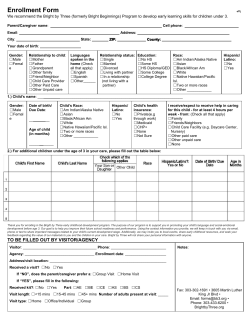
Bright Futures Preventive Services Quality Improvement Measures
Bright Futures Preventive Services Quality Improvement Measures Bright Futures provides a set of materials and measures to track and document preventive care activities and services. These resources facilitate engagement of pediatric health care professionals in performing quality improvement (QI) activities at the practice level or in partnership with others at the state or community level that will improve preventive care and achieve outcomes related to the Bright Futures goals of disease prevention, risk and disease detection, and health promotion. Bright Futures Preventive Services QI Measures Measurement is a critical step in "translating" the Bright Futures: Guidelines for Health Supervision of Infants, Children, and Adolescents into quantifiable components through chart audit and/or office systems inventory. The list below combines nationally endorsed measures and measures tested in, or adopted from, previous QI preventive services projects. To be included, the measures must reflect an important component of Bright Futures Guidelines and be appropriate for practice change over time. This list is designed to be dynamic and will be updated as new components of high-quality care preventive service visit are identified and tested. See the Clinical Practice section of the Bright Futures Web site for tips on how to use the core tools in Bright Futures Guidelines. Infancy & Early Childhood • • • • • • • • ABOUT BRIGHT FUTURES Bright Futures is a national health promotion and prevention initiative, led by the American Academy of Pediatrics and supported by the Maternal and Child Health Bureau, Health Resources and Services Administration. The Bright Futures Guidelines provide theory-based and evidence-driven guidance for all preventive care screenings and well-child visits. Bright Futures content can be incorporated into many public health programs such as home visiting, child care, schoolbased health clinics, and many others. Materials developed especially for families are also available. Learn more about Bright Futures and get Bright Futures materials by visiting brightfutures.aap.org Elicit and address patient/family concerns Perform developmental and autism screening and follow-up Elicit and discuss patient/family strengths Perform age-appropriate risk assessment and medical screening Measure and plot weight for length at 9 months and body mass index (BMI) at 24 months Perform maternal depression screening and follow-up Perform oral health risk assessment Provide anticipatory guidance Bright Futures Preventive Services Quality Improvement Measures Middle Childhood & Adolescence • • • Elicit and address patient/family concerns Perform developmental surveillance/identification of patient strengths • • • • • Perform chlamydia screening and follow-up Perform risk assessments and medical screening (vision, hearing, TB, anemia, dyslipidemia, alcohol/substance abuse, STIs, and measure and plot BMI % based on age and gender) Perform HIV screening and follow-up Perform adolescent depression screening and follow-up Perform cholesterol screening and follow-up Provide anticipatory guidance 6 Office-Based System Measures (for both groups) 1. 2. 3. 4. 5. 6. Use a preventive services prompting system Use a recall/reminder system (to address immunizations and well-child visits) Use a system to track referrals (paper based or electronic) Use a system to identify children with special health care needs Link families to appropriate community resources Use a strength-based approach and a shared decision-making strategy Do you have a story to tell about how you’ve implemented Bright Futures in your practice or in your state? Please contact us today so that we can feature your implementation story on our Web site or in a future edition of the Bright Futures eNews. Jane Bassewitz, MA, Manager, Bright Futures National Center Kathy Janies, Bright Futures Implementation Manager brightfutures.aap.org e-mail us at brightfutures@aap.org Last updated: April 2015 Downloaded from: brightfutures.aap.org
© Copyright 2025











